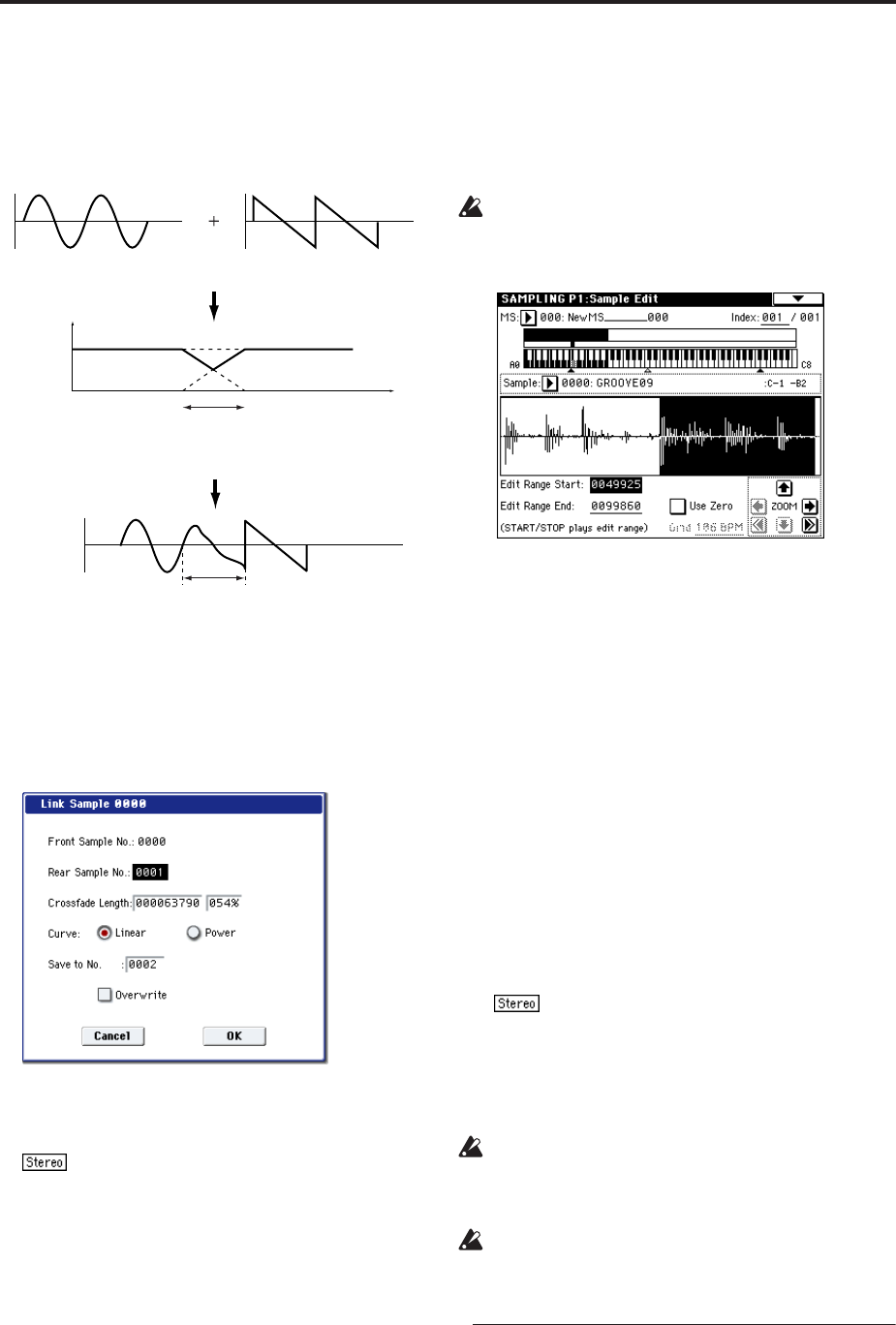
Sampling mode
628
The volume of the two samples can be changed
gradually at the transition to gradually mix the
samples with each other. This is called crossfade, and
can be used to produce a natural-sounding transition
between the two sounds.
“Link” will be executed for all of the selected sample
data, regardless of the “Start” and “End” settings.
1. Use “Sample Select” (1–1b) to select the sample
that will be placed in front by the Link command.
2. Select “Link” to open the dialog box.
3. The sample number selected for “Front Sample
No.” will be displayed. When the command is
executed, this sample will be placed in front.
If you select one side of a stereo sample, it
will automatically be detected as a stereo sample,
and the other side of the sample will also be
processed by the Link command.
If the “Front” Sample is mono and the Rear Sample
is stereo, the L and R of the “Rear” Sample will be
mixed to mono before linking.
If the “Front” Sample is stereo and the “Rear”
Sample is mono, the identical sample will be placed
in L and R of the “Rear” Sample before linking.
4. Use “Rear Sample No.” to select the sample
number that will be linked.
When the command is executed, this sample will be
placed in back.
5. In “Crossfade Length,” specify the length over
which the crossfade will occur.
If you specify a % value, the proportion in relation
to the entire “Front” Sample will be calculated
automatically. If you specify 50%, the last half of the
“Front” Sample will crossfaded.
If the rear sample is short, the “Crossfade Length”
cannot be set any longer than the length of the “Rear
”sample. In this case, it will not be possible to
specify a value up to 100%.
After selecting a sample in step 1, you can set
“Start” and specify the beginning of the crossfade
while viewing the waveform. Set “End” to the end
of the sample. If you specify these, “Crossfade
Length” will indicate the length determined by
“Start” and “End.”
6. In “Curve,” specify how you want the volume to
change in the crossfaded portion.
Linear: The volume will change linearly.
Power: The volume will change non-linearly. In
some cases, “Linear” may sound as though the
volume diminishes in the middle of the curve. If this
occurs, use “Power.”
7. In “Save to No.,” specify the save destination
sample number.
An unused sample number will be selected by
default.
The sample number cannot be specified if
“Overwrite” is checked (page 615).
For stereo samples, use “Save to No.(L)” and
“(R)” to specify the save-destination of the L and R
channels.
8. To execute the Link command, press the OK
button. To cancel without executing, press the
Cancel button.
If you link samples of different sampling rates (such
as created by “Rate Convert”), the newly created
sample will have the sampling rate of the “Front”
sample.
One vacant sample is used in order to execute Link.
Be aware that if there are no vacant samples, an
error will occur.
Truncate (for Loop Edit)
This command deletes unwanted data that lies outside
of the “Start (Start Address),” “Loop Start (Loop Start
Address),” and “End (End Address)” (2–1d). After
SOUND A SOUND B
SOUND A
SOUND B
CROSSFADE LINK
Crossfaded portion
(Sound A gradually diminishes,
and sound B gradually increases)
Crossfaded portion
(This is called the “Crossfade Length”)
Volume
Time


















